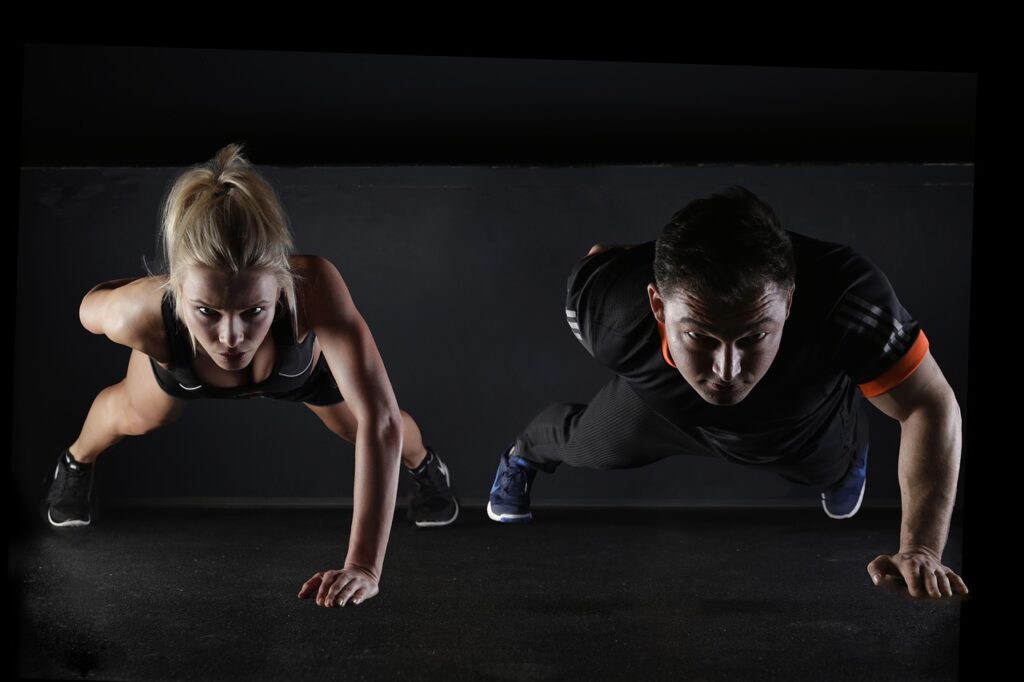From PT school, I was taught that eccentric exercises builds up more muscle bulk than concentric exercises. But like many things we learnt in theory, I struggled to accept that. I mean, concentric exercises felt like the real deal. You get to see the muscle pumping up and envision all the bulk you could get by the end of the week. Just so I am not biased in my judgment of exercise types, I put them to the test, or rather tried an extended version of eccentrics. I walked a 20 kg weight on both arms – outstretched (so 40 kg really) up the stairs (a chore actually), and I was so exhausted by the fourth flight of stairs. I had to do this 5 times, so you can imagine how drained I was. After I had rested, I got thinking about the physiology behind such a mechanism/exercise, hence, concentric vs eccentric exercises.
What is the Concentric Phase?

Concentric exercise or the concentric phase is the type of muscle strengthening exercise where the muscle shortens to produce some force. In simple terms, concentric exercises involve muscle fibers shortening under load. Think of lifting a dumbbell up. That upward move is concentric. It’s the “hard” part of a lift. Muscles contract and shorten. This builds strength and grows your muscle… but compared to eccentric? That’s what you’re about to find out. Concentric work is what makes functional movement possible. As basic as bathing and feeding, requires some concentric effort.
The key features
- Muscle shortening under tension.
- Often called the “lifting” phase.
- Common in strength training routines.
Examples:
- Curl up in a bicep curl.
- Pushing up in a push-up.
- Standing from a squat.
Benefits of Concentric Exercise
- Concentric exercises help you feel stronger.
- They aid in muscle hypertrophy (AKA muscle bulking).
- They improve performance in daily tasks.
- They can lift you out of a strength plateau.
- When you focus on concentric moves, you see faster strength gains.
- Overall, they can boost your motivation. Besides, quick wins matter, and feeling some progress will keep you going.
What is Eccentric Exercise?

Eccentric exercise is a type of strengthening exercise that increases muscle length to produce force. It involves muscle fibers lengthening under tension or resisting a load. For instance, lowering a dumbbell slowly, that downward move is eccentric. Muscles control the descent, and this phase helps build strength and muscle growth in a unique way. Ansari et al. (2023) confirmed this in a review, showing that eccentric exercises significantly increased isometric, eccentric, and overall strength. Eccentric work also supports joint health and stability.
Key Features
- Muscle lengthening under tension.
- Often called the “lowering” or “negative” phase.
- Common in resistance training routines.
- Slower tempo increases muscle engagement.
Examples
- Lowering in a bicep curl.
- Squatting in a squat-stand.
- Lowering the chest in a push-up.
Benefits of Eccentric Movement
- Eccentric exercise boosts strength and control.
- It helps break through plateaus.
- It can improve muscle fiber recruitment.
- It aids tendon resilience over time.
- It often leads to greater long-term gains.
- It may improve workout efficiency.
- It can support injury rehab when used wisely.
- It adds variety to routines for steady progress.
What is Isometric Contraction?

Isometric contractions occur when muscles generate force without changing length. It’s like pushing against an immovable object. The muscles are acting, but don’t shorten or lengthen. It’s like holding a plank or doing a wall sit. You might feel shaky in those moments, and holding too long can cause muscle burn. You have to start with short holds, then gradually increase hold time to manage the discomfort and for steady gains. Add rest breaks between sets to avoid fatigue.
Key Features
- Muscle length stays constant under tension.
- Common in static holds and balance drills.
- No visible movement at the joint.
- Often used in rehabilitation and endurance training.
Benefits of an Isometric Contraction
- Isometrics boost joint stability and core strength.
- They improve muscular endurance without heavy loads.
- They help you master challenging positions.
- They reduce joint stress compared to dynamic lifts.
- They’re great for busy schedules. With a few reps, you can build strength.
Difference between Concentric and Eccentric Exercises
Concentric and eccentric phases work in opposite ways. Yes, they both build strength and size. Yet they feel and act differently. Understanding their key differences will help you plan smarter workouts.
| Concentric Exercise | Eccentric Exercise |
| The muscle fibers shorten under load when you lift. Hence, it feels like a push. | The muscle fibers lengthen under load when you lower them. |
| Concentric focus leads to quick strength gains and a sense of power. | Eccentric recruits more muscle fibers and makes the tendons resilient. |
| Causes mild post‑workout soreness. | Often triggers stronger, delayed soreness. |
Bottom Line: Concentric or Eccentric Exercise
I love concentric exercises, if not for anything, for the muscle eye candy. I love seeing my muscles at their widest diameter when I do a biceps curl. But let’s be real, the muscle soreness after an overextended routine is no joke. They can stress the muscles and joints, leading to imbalance and tendon issues. Eccentrics aren’t entirely innocent. Those slow lowering movements can cause delayed soreness, especially for beginners.
To cope with these, your muscles need varied stimuli. Include both concentric and eccentric phases to appreciate your bulking journey better and deal with fewer plateaus. Start with a light weight to manage the discomfort. Too much volume may stress muscles or tendons. Lift with control and lower the weight slowly during the eccentric phase.
At peak muscle contraction, pause briefly. Repeat with good form. Aim for 8–12 reps per set. Adjust the load as you get stronger. Track your weights to see progress. Include bodyweight exercises if you don’t have much equipment (or if you plan on exercising from home on most days).
Tips for Better Results
- There’s a principle of neuroplasticity called “Motor imagery and mental practice.” Here you can consider it as a mind-muscle link. You think about (or look at) the muscle you’re exercising during each movement. This helps to engage more neural circuits in the brain and boosts performance.
- Breathe out as you lift.
- Rest well between sets.
- Fuel your body with protein-rich foods to support repair.
- Warm up before heavy lifts and eccentric-focused sets.
- Include dynamic stretches and light reps in your routine.
- Cool down with light stretches.
- Listen to your body for signs of fatigue to avoid overtraining.
- Use foam rolling or massage to ease soreness.
- Vary exercises to avoid monotony and imbalances.